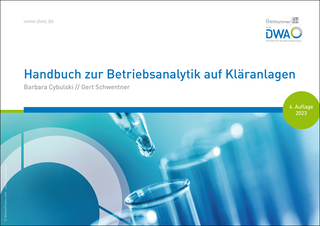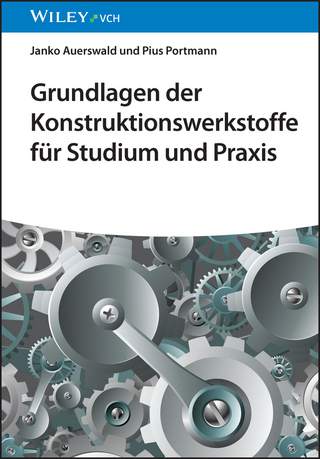What is What in the Nanoworld
Wiley-VCH (Verlag)
978-3-527-41141-2 (ISBN)
- Titel leider nicht mehr lieferbar
- Artikel merken
Dieses Handbuch fasst in mehr als 2.200 präzise formulierten Einträgen Begriffe, Definitionen, Phänomene und Gesetzmäßigkeiten der Chemie, Physik, Materialwissenschaften und Technologie von Nanostrukturen auf einführendem Niveau zusammen.
Victor E. Borisenko graduated in 1973 from the Belarusian State University of Informatics and Radioelectronics (BSUIR) as an engineer in semiconductor electronics. After gaining doctorates in physics and mathematics, he accepted a post as professor at BSUIR in 1990. He currently holds a chair at the Department of Micro- and Nanoelectronics and supervises the Center of NanoeIectronics and Novel Materials at BSUIR. His research team focuses on fundamental electronic and optical properties of semiconducting oxides and other compounds, low dimensional silicon, and germanium nanostructures. Professor Borisenko has been organizing international conferences on physics, chemistry and applications of nanostructures since 1995. Stefano Ossicini graduated in physics from the University of Rome. From 1978 to 1982 he worked as a post-doc and an assistant at the Free University of Berlin, Germany, and afterwards as a researcher at the University of Calabria, Italy, until 1984, when he accepted a post at the University of Modena. Professor Ossicini is Director of the Research Center "En&Tech? for green energies at the University of Modena and Reggie Emilia, and is an associate with the CNR-Istituto Nanoscienze S3. While his research activities have always been focused on the theory of low-dimensional and nano-systems, he now concentrates on investigating the structural and optoelectronic properties of nanostructures.
Preface to the Third Edition VII
Sources of Information IX
A From Abbe's principle to Azbel'-Kaner cyclotron resonance 1
B From B92 protocol to Burstein-Moss shift 31
C From C-AFM (conductive atomic force microscopy) to cyclotron resonance 61
D From D'Alembert equation to Dzyaloshinskii-Moriya interaction 93
E From (e,2e) reaction to Eyring equation 123
F From Fabry-P'erot resonator to FWHM (full width at half maximum) 151
G From gain-guided laser to gyromagnetic frequency 179
H From habit plane to hyperelastic scattering 195
I From IBID (ion-beam-induced deposition) to isotropy (of matter) 219
J From Jahn-Teller effect to Joule's law of electric heating 229
K From Kadowaki-Woods ratio to Kuhn-Thomas-Reiche sum rule 233
L From lab-on-a-chip to Lyman series 249
M From Mach-Zender interferometer to Murrell-Mottram potential 277
N From NAA (neutron activation analysis) to Nyquist-Shannon sampling theorem 315
O From octet rule to oxide 335
P From PALM (photoactivable localization microscopy) to pyrrole 343
Q From Q-control to qubit 383
R From Rabi flopping to Rydberg gas 405
S From Sabatier principle to synergetics 423
T From Talbot's law to type II superconductors 503
U From ultraviolet-assisted nanoimprint lithography (UV-NIL) to Urbach rule 525
V From vacancy to von Neumann machine 531
W From Waidner-Burgess standard to Wyckoff notation 539
X From XMCD (X-ray magnetic circular dichroism) to XRD (X-ray diffraction) 551
Y From Yasukawa potential to Yukawa potential 555
Z From Zeeman effect to Zundel ion 557
Appendix 561
A list and a presentation of Scientific Journals which contain the stem Nano in their title 563
Abbreviations for the scientific journals which appear as sources in the text 585
Appendix - main properties of intrinsic (or lightly doped) semiconductors 591
Zur ersten Auflage:"... 1300 Begriffe und Definitionen, wichtige Phänomene, Festlegungen, experimentelles und theoretisches Handwerkszeug sowie Andwendungen aus den Bereichen allgemeine Physik, Quantenmechanik, Werkstoffwissenschaften, Mathematik, Informationstheorie, organische und anorganische Chemie, Festkörperphysik und Biologie für Anfänger und Experten ..."Materials and Corrosion/Werkstoffe und Korrosion2005, Vol. 56, No. 7
"This is a very useful handbook for the professional. It has useful definitions for terms ranging from simple to very complex. It is designed for a wide audience of professional scientists who will be experts in their own field, but may need help in understanding some terms from other areas."Chromatographia"... a useful and readable resource, especially for undergraduate students and those elements in the general public interested in nanotechnology."American Reference Books Annual"...a useful handbook for undergraduate and PhD students as well as for teachers and researchers interested in nanoscience and nanotechnology from the physical/solid-state viewpoint. But is is also useful to chemists who are trying to move towards broader horizons."Advanced Materials"The book is very useful to both workers in the field and those who are interested in understanding the term and expression used in greater detail and the book will make a valuable addition to any bookshelf of the interested reader. It will be of use to university teachers, managers and media professionals dealing with nanoscience and nanotechnology."Journal of Materials Technology"... useful to advanced graduate students beginning research projects, or to scientists and engineers reaching outside the bounds of their disciplines for work in nanotechnology."CHOICE"Borisenko and Ossicini, both professors of physics, have filled a gap in nanoscience by writing this book. Overall, it promises to be a valuable source of information for scientists, researchers and research students who are dealing with materials and nanotechnology."Materials World
| Erscheint lt. Verlag | 22.8.2012 |
|---|---|
| Verlagsort | Weinheim |
| Sprache | englisch |
| Maße | 170 x 240 mm |
| Gewicht | 1284 g |
| Themenwelt | Naturwissenschaften ► Chemie |
| Technik ► Maschinenbau | |
| Schlagworte | Anorganische Chemie • Chemie • Chemistry • Festkörperchemie • Festkörperphysik • Halbleiterphysik • Inorganic Chemistry • Materials Science • Materialwissenschaften • Nanomaterialien • nanomaterials • Nanophysics • Nanophysik • Nanostruktur • Nanotechnologie • Nanotechnologie; Handbuch/Lehrbuch • nanotechnology • Organic Chemistry • Organische Chemie • Physics • Physik • Quantenphysik u. Feldtheorie • Quantum Physics & Field Theory • Quantum Physics & Field Theory • Semiconductor physics • solid state chemistry • Solid state physics |
| ISBN-10 | 3-527-41141-0 / 3527411410 |
| ISBN-13 | 978-3-527-41141-2 / 9783527411412 |
| Zustand | Neuware |
| Haben Sie eine Frage zum Produkt? |
aus dem Bereich




